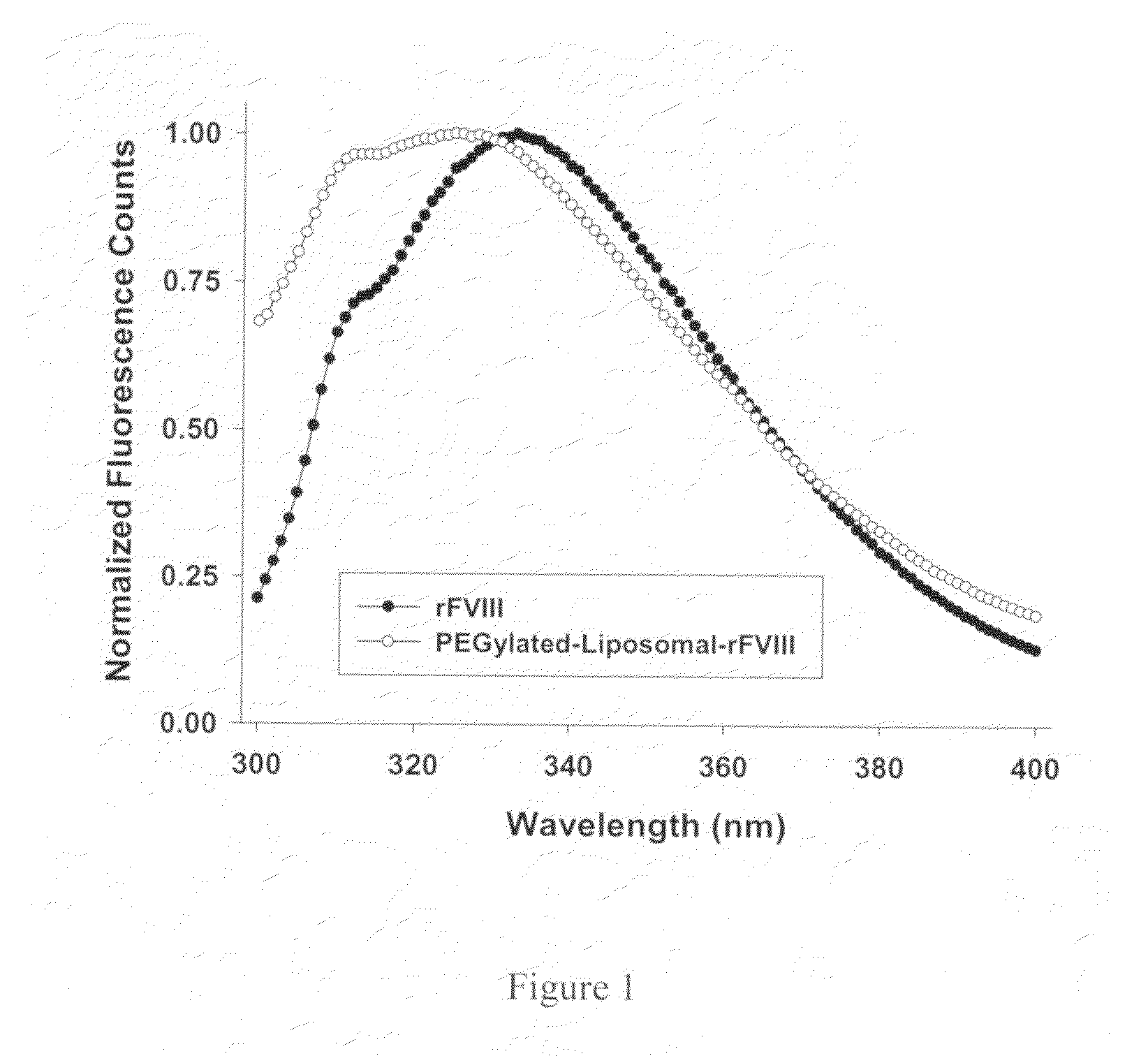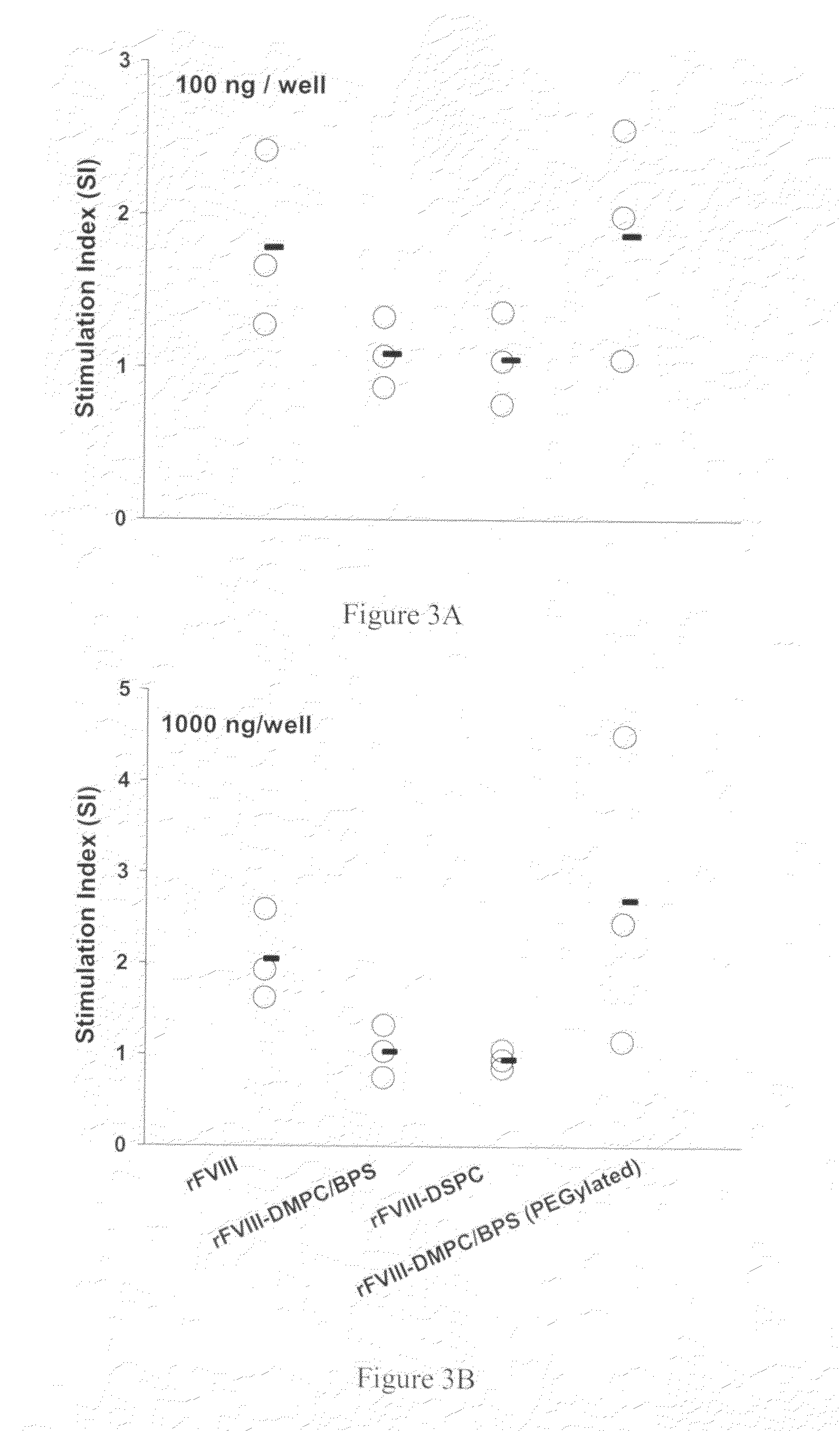Compositions and methods for less immunogenic protein-lipid complexes
a technology of protein-lipid complexes and complexes, applied in the field of compositions and methods for reducing the immunogenicity of therapeutics, to achieve the effects of reducing the immunogenicity, reducing the production of il-10, and reducing the titer
- Summary
- Abstract
- Description
- Claims
- Application Information
AI Technical Summary
Benefits of technology
Problems solved by technology
Method used
Image
Examples
example 1
[0041]This example describes the preparation of PC containing liposomes. In this example, the protein was first associated with PS containing liposomes and then PEG was added.
Materials
[0042]rFVIII (Baxter Biosciences, Carlsbad, Calif.) was used as the antigen. Normal coagulation control plasma and FVIII deficient plasma for the activity assay was purchased from Trinity Biotech (Co Wicklow, Ireland). Brain phosphatidylserine (BPS), dimyristoyl phosphatidylcholine (DMPC) and 1,2-dimyristoyl-sn-glycero-3-phosphoethanolamine-N-[methoxy(polyethylene glycol)-2000] (DMPE-PEG2000) dissolved in chloroform were obtained from Avanti Polar Lipids (Alabaster, Ala.), stored at −70° C. and used without further purification. Sterile, pyrogen-free water was purchased from Henry Schein Inc. (Melville, N.Y.). Goat anti-mouse immunoglobulin (Ig, IgM+IgG+IgA, H+L) conjugated to alkaline phosphatase was from Southern Biotechnology Associates, Inc. (Birmingham, Ala.). Monoclonal antibody ESH 8 was obtaine...
example 2
[0047]These example describes the characteristics of the liposomes prepared in Example 1.
[0048]Emission spectra of rFVIII and rFVIII associated with PEGylated liposomes were obtained using a fluorometer (Quanta Master, Photon Technology International, Lawrenceville, N.J.). The samples were excited at 280 nm and the emission spectrum was obtained from 300-400 nm. A slit width of 4 nm was used on both the excitation and emission paths. The protein concentration was ˜4 μg / ml and a variable pathlength cuvette was used to minimize inner filter effects.
[0049]Tertiary structural changes in the protein were investigated by fluorescence spectroscopy (FIG. 1). The emission spectrum of free FVIII showed an emission maximum of 333 nm. The protein associated with PEGylated liposomes displayed a significant blue shift in the emission maxima to 325 nm and was accompanied by a large increase in intensity (data not shown). The pronounced blue shift in emission maximum sugges...
example 3
[0050]This example describes the preparation of PS containing micelles. Lipid films comprised of dicaproyl phosphatidylserine (DCPS) and dicaproyl phosphatidylthioethanol (DCPSE) (97:3 molar ratio, total lipid 5 μmoles) were prepared from a chloroform stock solution by evaporating the solvent in a rotary evaporator. The films were reconstituted with 1 mL Tris buffer (5 mM CaCl2, 25 mM Tris and 300 mM NaCl, pH=7) by vortex mixing to obtain 5 mM lipid solutions. Concentrated rFVIII stock was diluted with the 5 mM lipid solution and incubated at 37° C. for 30 minutes. The PEGylation approach is similar to the PEGylation of the preformed liposomes using activated PEG molecules. PEGylation was achieved by coupling an activated PEG molecule (linear or branched mPEG maleimide) to the free thiol group present on the phospholipid headgroup (DCPSE).
PUM
| Property | Measurement | Unit |
|---|---|---|
| concentration | aaaaa | aaaaa |
| mole % | aaaaa | aaaaa |
| diameter | aaaaa | aaaaa |
Abstract
Description
Claims
Application Information
 Login to View More
Login to View More - R&D
- Intellectual Property
- Life Sciences
- Materials
- Tech Scout
- Unparalleled Data Quality
- Higher Quality Content
- 60% Fewer Hallucinations
Browse by: Latest US Patents, China's latest patents, Technical Efficacy Thesaurus, Application Domain, Technology Topic, Popular Technical Reports.
© 2025 PatSnap. All rights reserved.Legal|Privacy policy|Modern Slavery Act Transparency Statement|Sitemap|About US| Contact US: help@patsnap.com



